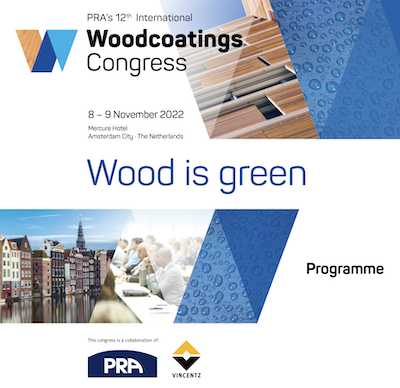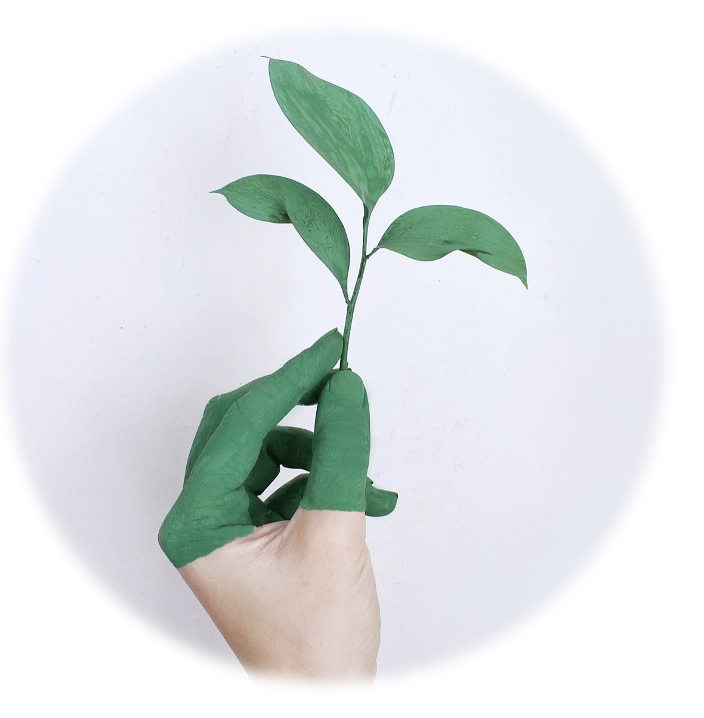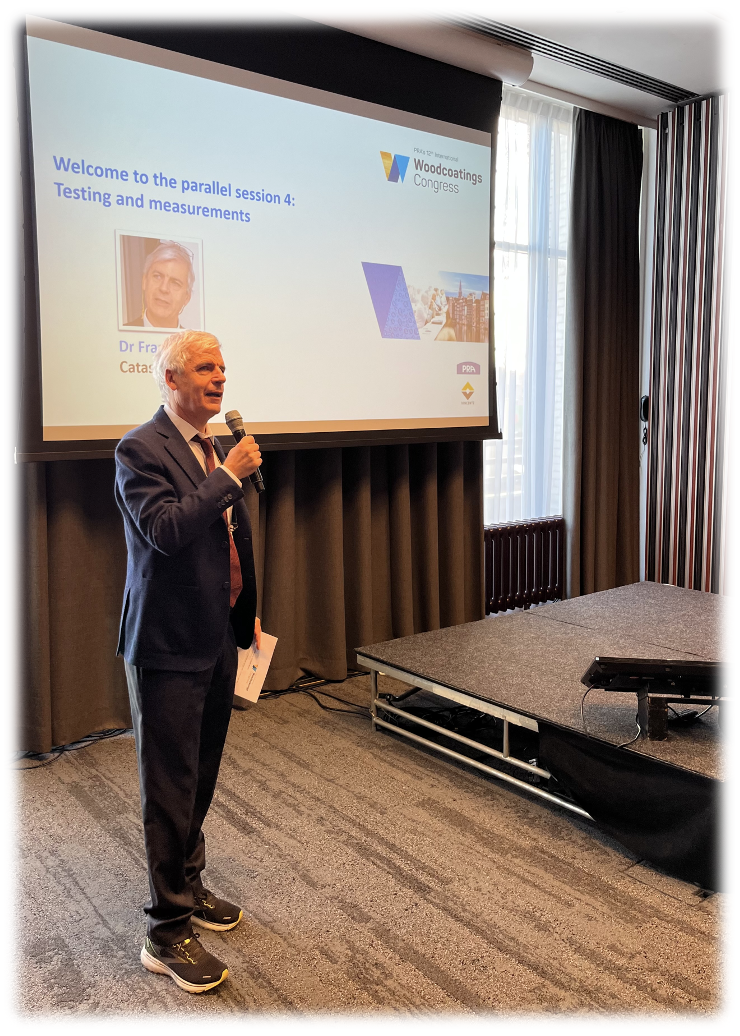
The twelfth edition of the Wood Coating Congress took place on 8 and 9 November 2022 in Amsterdam, an event of international importance which is held every two years and which attracts experts and companies from all over the world.
This edition was particularly awaited as the 2020 appointment had been canceled due to the pandemic and consequently the opportunity for a meeting between experts and leading companies in the sector had regrettably vanished. The congress is in fact an event full of information on the market situation, on regulatory developments and on new proposals in terms of raw materials, coatings products and technologies.
The inspiring theme of the 2022 edition of the Woodcoating Congress was "sustainability". This subject was considered by different speakers with detailed technical analyses. Alongside this main subject, various other topics of general interest were presented which we briefly try to resume and summarize in this short article. Obviously, this is a very partial report and reference is made to the conference proceedings for further details.
The wood coatings market
A first fact that we believe is important to report concerns the general market of coating materials for the wood and furniture sector. The data presented during the congress show of a global demand of around 2.9 million tons of coating products. Solvent-based coatings and in particular two-component polyurethanes are still the leading products on the market with a percentage of around 46%. This is followed by water-based coatings (24%), then the "old" nitrocellulose coatings (12%), photo-curable or UV coatings (10%), acid-curing coatings (4.5%) and unsaturated polyesters (3.5%).
This analysis combined with the topics covered during the congress show that the change towards technologies with less impact on the environment is certainly desired, pursued by many producers and users, but actually not very perceptible in terms of global data.
Sustainability
What is the real meaning of this term for wood coatings?
Various speakers tried to answer this question starting from the evidence that the term sustainability contains many meanings and many values that the coating world is called to consider, also finding the right balance between several expectations that can sometimes even appear contradictory:
- Raw materials from renewable sources. For the production of coatings, raw materials deriving from renewable sources can already be used, but their impact on the environment in general terms must still be assessed. If, for example, the indispensable monomers and resins with which coatings are produced derive from the so-called "green chemistry", it is necessary to evaluate the possible competitions with the food sector and in any case with the need to further increase the extension of agricultural land to respond to these new, not negligible, needs. Not only resins and monomers, but also matting agents and flame retardants (derivatives of cellulose) that can now derive from these renewable sources were presented during the congress.
- Recyclability. The thickness of a coatings film applied to a wooden substrate is generally very low (sometimes a few tens of microns) and therefore any possibility of recovery at the end of its life (for example the paint present on an old window or door) would become onerous and economically unsustainable. Furthermore, the subsequent treatment and reuse process would encounter many difficulties in having to handle chemically different products. More applicable, and already concretely exploited, is the recycling of overspray, i.e. the coatings fraction that, applied with a spray gun, does not reach the coated element but is dispersed in the painting environment. Especially in the case of water-based coatings, this recovery can be managed directly by the painter or sent to the coatings manufacturer for the necessary formulation "adjustments". Moreover in terms of overspray, during the conference there was a reference to a particular spray system of new conception and already used for metal which, in fact, eliminate the overspray or in any case significantly reduce it.
- In the case of water-based coatings, the possibility of avoiding or in any case reducing the percentage of
 water present in the formulations, which is normally around 60%, was also presented. The production of high solid-content water-based coatings has been proposed as an interesting reality for reducing costs and the environmental impact of transports. While the production of a sort of "concentrated coatings ", to be diluted for use, has only been mooted, albeit with a little skepticism, but the challenge has been launched...
water present in the formulations, which is normally around 60%, was also presented. The production of high solid-content water-based coatings has been proposed as an interesting reality for reducing costs and the environmental impact of transports. While the production of a sort of "concentrated coatings ", to be diluted for use, has only been mooted, albeit with a little skepticism, but the challenge has been launched...
- Coating drying. The subject of sustainability involves also the coatings drying. The temperatures of the ovens and the permanence times of the painted pieces inside them depend significantly on how a coating material is formulated. New types of resins, developed with this new vision, therefore make it possible to reduce drying times and, consequently, the energy consumption involved. The greater effectiveness in hardening of the coating, obtained with these new formulations, also leads to possible advantages as regards some of its properties such as, for example, the rapid development of water resistance for exterior coatings.
- The production of monomers from recycled resins and plastics. One of the speeches presented an interesting development in the recycling of polymeric materials. The proposed strategy, in fact, is not to reuse these materials as they are due to the difficulties inherent in the recycling of products that are already "aged" and in any case not pure as they are processed and mixed with additives, dyes, plasticizers, etc. The novelty lies in subjecting these end-of-life polymeric materials to depolymerization processes in order to regain and separate the starting molecules with which they were produced. In this way it is possible to produce new resins and new plastic materials in the same way in which primary ingredients are used, i.e. the basic monomers obtained from the fractionation of hydrocarbons. A very interesting novelty that has aroused a lot of interest.
Functionalized surfaces
This theme was declined in different ways by three speakers. In few words, these are technologies that allow the deposition of conductive metal films on furniture in order to produce interactive surfaces that can open up new horizons in the field of home automation, self-diagnostics and more generally in the production of "smart" surfaces. In any case, these are issues essentially relating to the world of research which, to date, do not yet show real practical applications.
Future regulations on chemicals
This subject was a sort of common thread which, without being openly addressed, nonetheless characterized the introductions or conclusions of various presentations.
Basically, we would like to underline how the regulations on the safety of raw materials are marching at a very accelerated pace leading to the potential limitation or even the banning of many products in the near future (solvents, monomers, additives, hardeners…).
For this reason, research must take a leap forward to find solutions in line with the new limitations and growing market expectations on the performance of paint products.
Matting agents
It is well known to all those operating in the coating sector that low gloss appearance is today a must that the market requires according to the expectations of the final consumer.
However, the matt effect brings with it several problems starting with the compatibility, dispersibility and modification of the rheological properties of the liquid coating by the matting agents which, evidently, must be used in large quantities to produce coatings with the required aesthetic effects. In addition, other possible criticalities such as the reduction of transparency and the possible reduction of some surface performance (resistance to cold liquids, scratches, etc.).
The world of coating formulations is therefore very sensitive to these new needs and some of the presentations really focused on how to solve these problems with innovative matting additives.
Powder coating
Powder coating was one of the topics addressed in almost every edition of the Woodcoating Congress. The benefits deriving from this completely solvent-free technology, however, collide with a series of difficulties which concern in particular the need to bring the wooden surfaces to the high temperatures necessary for the melting of the powder coatings. In the 2022 edition, the results of a research were presented which had the aim of applied powder coatings on WPC (wood-plastic composite) elements. The use of conductive agents in the WPC formulation and a plasma treatment to increase the surface energy have proved to be effective strategies for solving the problem.
Tests and measurements
This session of the Woodcoating Congress was entrusted to Catas which moderated a series of presentations concerning various topics, among which: the optimal methods of measuring the thickness of the coating films, the effects of the vapor permeability of window coatings, the variations of the mechanical characteristics of the applied coatings during aging, the ability of the coatings to reduce resin bleeding and other issues concerning both natural and artificial aging systems. This session was certainly one of the richest in experimental data and curiosity by the audience who underlined their interest with particularly lively debates.
At this point, after these brief notes on the twelfth edition of the Woodcoating Congress, let's start setting the appointment for autumn 2024 on the agenda!
https://www.european-coatings.com/woodcoatings
For info:Franco Bulian
0432 747231
bulian@catas.com



 water present in the formulations, which is normally around 60%, was also presented. The production of high solid-content water-based coatings has been proposed as an interesting reality for reducing costs and the environmental impact of transports. While the production of a sort of "concentrated coatings ", to be diluted for use, has only been mooted, albeit with a little skepticism, but the challenge has been launched...
water present in the formulations, which is normally around 60%, was also presented. The production of high solid-content water-based coatings has been proposed as an interesting reality for reducing costs and the environmental impact of transports. While the production of a sort of "concentrated coatings ", to be diluted for use, has only been mooted, albeit with a little skepticism, but the challenge has been launched...